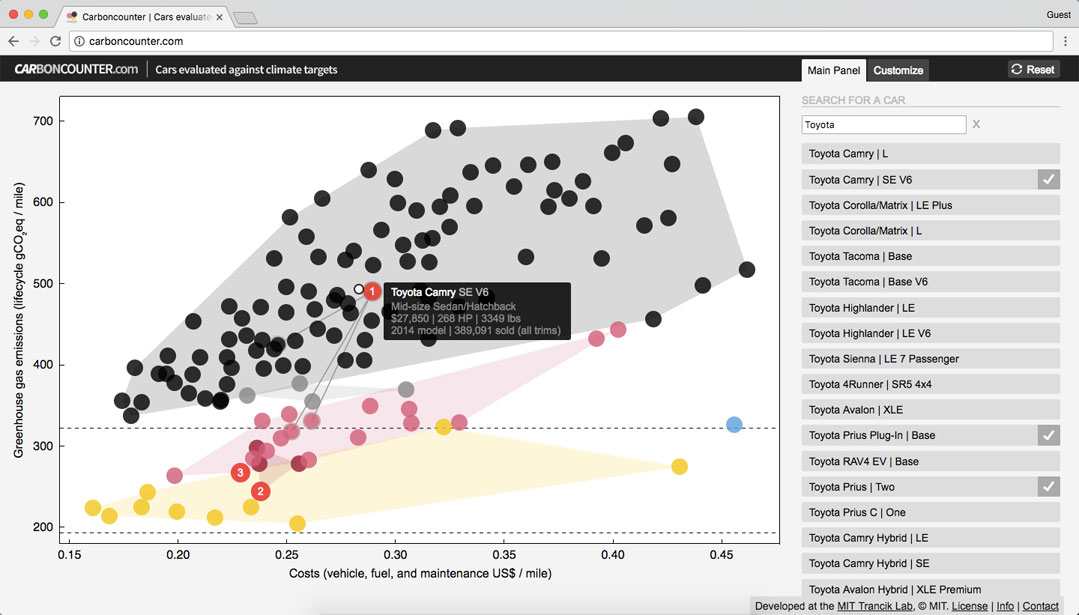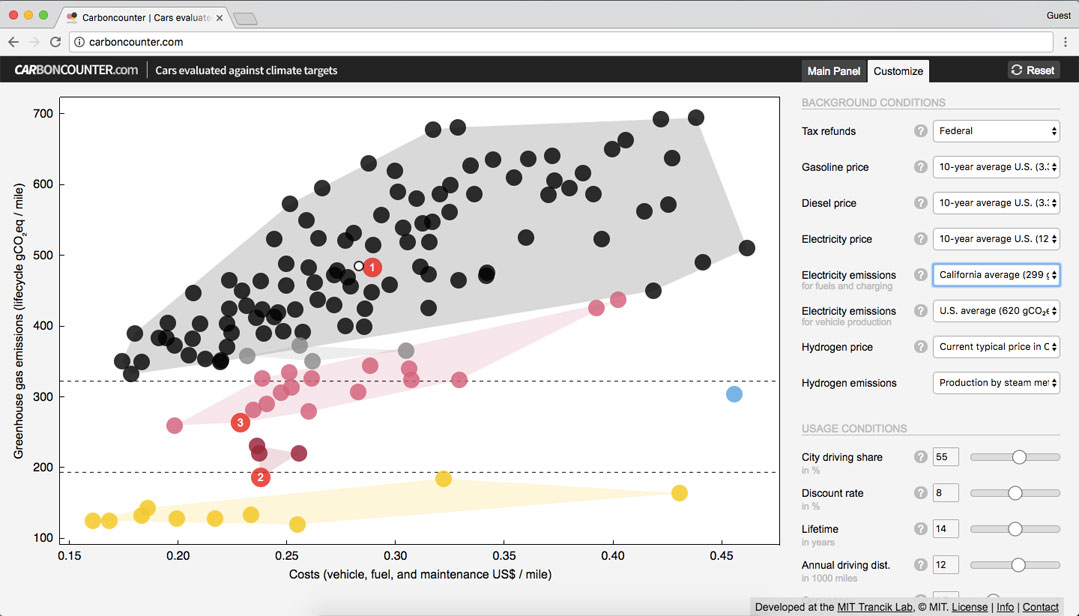Shopping for a (Not too Expensive) Car that's Better for the Environment? There's an app for that.
The MIT CarbonCounter helps you find the least polluting cars on the market and evaluate their cost
Video by MIT News
Buying a vehicle can be a harrowing task for any environmentalist. Not only is it difficult to determine which options are the least carbon intensive, but it’s also a stressful financial decision when you’re confronted with the fatter price tag of, say, a Tesla over a Camry.
Fortunately, a team of MIT researchers has created a web app that shows you the environmental and financial costs of a car based on how often you drive and where you live. The MIT CarbonCounter app allows users to compare the lifecycle cost and greenhouse gas emissions per mile of 125 of the most popular cars in the United States. The good news? When you factor in costs across purchase, maintenance, and operation, low-emissions vehicles are often less expensive than their fuel-guzzling counterparts.
In order to collect data for the app, the research team conducted a study that they published at the end of September. Jessika Trancik, associate professor of energy studies and the lead author of the study, says that the research is part of a larger effort to understand how currently available and in-development technologies can help meet climate targets. She specifically focused on cost in this study because of its importance to consumers.
“For a clean-energy transition to happen, investors have to decide to invest in cleaner technologies, and in this case, the key decision-makers, the key investors are private citizens who are deciding which cars to buy, as well as which cars to rent,” she says.
Using the CarbonCounter is pretty straightforward. When you open up the web page, you see a graph of all 125 types of vehicles plotted against cost and carbon axes. The horizontal dotted lines that cut across the chart represent federal emissions targets for 2030, 2040, and 2050. In the search bar on the right-hand side, you can type in the name of the car you’d like to find. If you type in “Toyota,” for example, it will generate a list of all the Toyota models available in the app. Clicking on “Toyota Prius | Two” will then highlight the corresponding dot on the graph in pink, which shows you how its price and emissions size up among all of the other vehicles'. If you want to weigh its performance against specific cars—perhaps the “Toyota Camry | SE V6” and the “Toyota Prius Plug-In | Base”—you can click on those models as well for an easy visual comparison of which has less impact on your wallet and the environment.

The app is set to calculate cost and carbon intensity based on U.S. averages, but if you want to get fancy, you can navigate to the Customize tab and adjust the parameters so they more accurately reflect your locale. For example, you can switch the “Electricity emissions” parameter to a “Midwest mix” or a “California average,” and you can use sliders to fine-tune the number of years and miles you expect to drive the car. That way, if you use the app to make any car-purchasing decisions, you can rest assured that the data reflects your lifestyle.

However, the app wasn’t designed with only consumers in mind. Trancik notes that it’s useful for policy makers as well. For instance, the app demonstrates how many of the electric vehicles available today are already capable of meeting 2050 emissions targets if powered by a fully decarbonized electricity supply. Policymakers and engineers alike can use findings like these to help bring all cars below emissions targets in the future.
Trancik is already planning several enhancements to the CarbonCounter. “For people to purchase an all-electric vehicle, they need to know that the range of the vehicle will meet their needs . . . [and] be able to predict on which days they are likely to exceed the range,” Trancik says. That’s why in August, her team of researchers published another study that looked at “what percentage of cars on the road could be replaced with a low-cost electric vehicle and still meet daily driving needs with only overnight charging.” It also included a predictive model for evaluating range, which Trancik hopes to integrate into the app soon.
Her lab has also begun research on additional car models, including two-wheeled vehicles and heavier-duty vehicles—many of them prompted by user requests—and they are working on translating the app to Spanish.
Trancik says, “I’m very interested in taking information on these societal-level climate change mitigation scenarios and translating that into information individuals can use to inform the choices that they’re making on a day-to-day basis.”
 The Magazine of The Sierra Club
The Magazine of The Sierra Club







